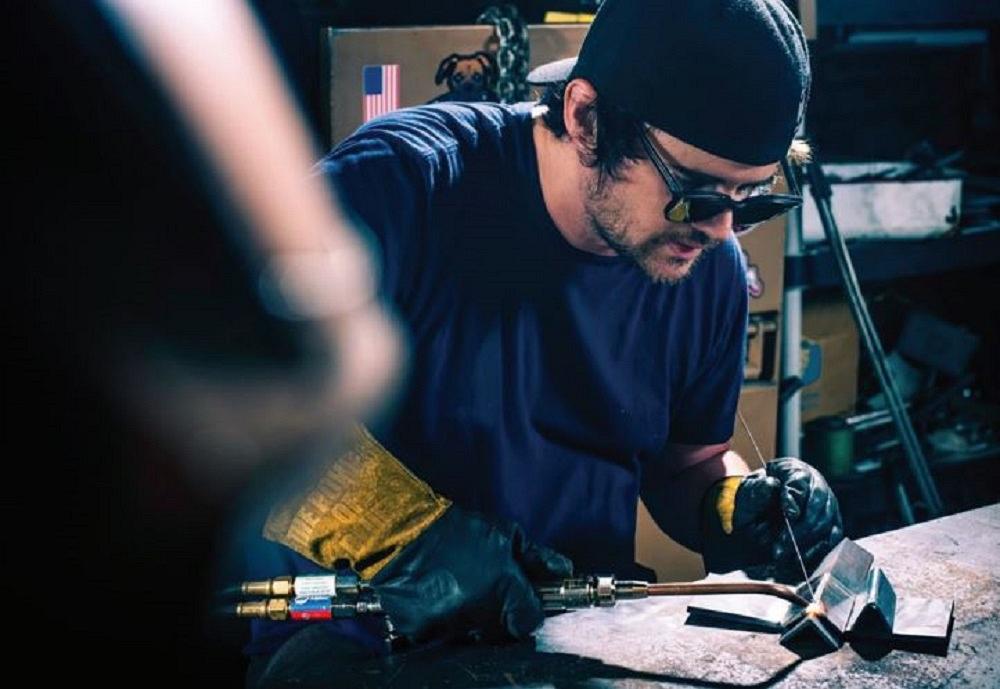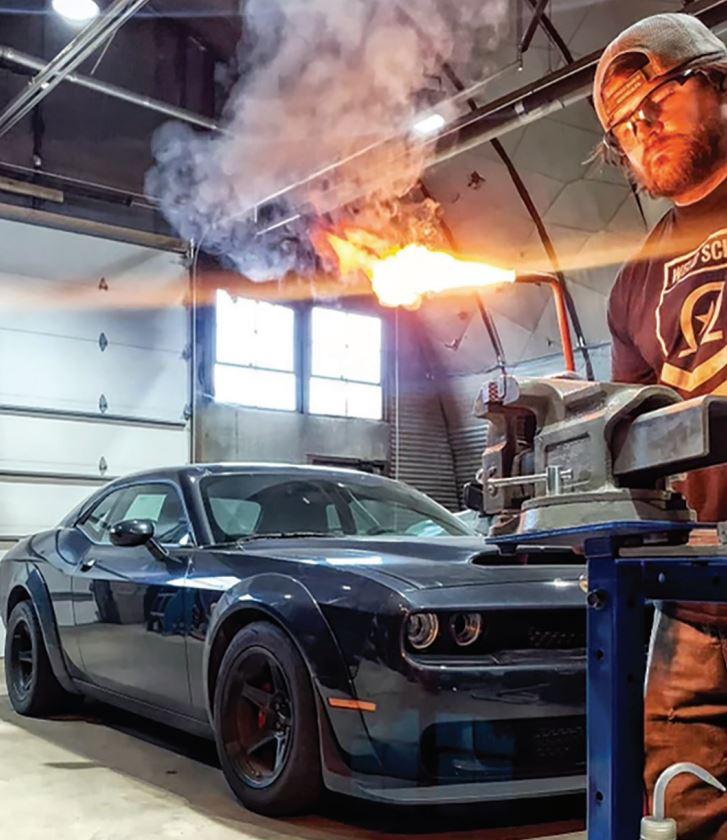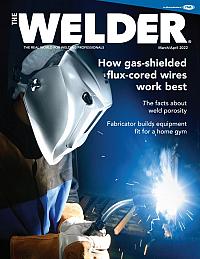Owner, Brown Dog Welding
- FMA
- The Fabricator
- FABTECH
- Canadian Metalworking
Categories
- Additive Manufacturing
- Aluminum Welding
- Arc Welding
- Assembly and Joining
- Automation and Robotics
- Bending and Forming
- Consumables
- Cutting and Weld Prep
- Electric Vehicles
- En Español
- Finishing
- Hydroforming
- Laser Cutting
- Laser Welding
- Machining
- Manufacturing Software
- Materials Handling
- Metals/Materials
- Oxyfuel Cutting
- Plasma Cutting
- Power Tools
- Punching and Other Holemaking
- Roll Forming
- Safety
- Sawing
- Shearing
- Shop Management
- Testing and Measuring
- Tube and Pipe Fabrication
- Tube and Pipe Production
- Waterjet Cutting
Industry Directory
Webcasts
Podcasts
FAB 40
Advertise
Subscribe
Account Login
Search
Playing with Fire: Dissecting the Hulk-like beast that is oxyacetylene in the fab shop
How harnessing the power of oxy-fuel welding, cutting has changed the game in metal fabrication
- By Josh Welton
- April 13, 2022
- Article
- Arc Welding

Oxyacetylene is a lot like the delicate balance between Marvel’s Dr. Banner and his alter ego the Incredible Hulk. It doesn’t take much to turn oxyacetylene from a fabricating powerhouse to a tool of mass destruction. Images: Josh Welton
Captain America, amid an otherworldly onslaught, has hope. While in the middle of an impossible battle for the soul of planet Earth, he knows he has a ringer.
“Dr. Banner, now might be a good time for you to get angry,” Captain America said.
“That's my secret, Captain: I'm always angry.”
Bruce then turns toward the hordes of attacking aliens and transforms into the Hulk, a massive, beastly, unkillable agent of chaos; a green monster so powerful it needs to be written out of some comic book stories just so the outcome isn’t a foregone conclusion. As the Hulk single-handedly demolishes a gargantuan metal space dragon in the streets of New York City, we know we have a chance.
Early on the Avengers try to use Hulk as a tool, but mainly in a “break glass in case of emergency” kind of way because even when they’re on the same page as him, the collateral damage is steep. He doesn’t lose, but he’s also dangerous AF.
What does any of this have to do with welding?
I was thinking about acetylene. Much like the Hulk, the potent gas’s origin story begins with a scientist and an accident. In 1836 Edmund Davy created a dark substance—potassium carbide—that reacted violently with water, producing a gas (acetylene) that burned brighter than anything known to man up until that point. Eventually mistakes by other scientists in the mid to late 1800s led to another murky dark matter—calcium carbide—which was a commercially viable source of acetylene. Automobile headlamps, lighthouses, and buoys were the early adopters of the gas as a combustible source for light. Inventions to conserve the gas, to burn it more efficiently, meant that even a remote lighthouse could re-up just once a year with enough fuel to last until the next visit.
Of course, there’s no such thing as a free lunch. Acetylene is insanely powerful but isn’t an easy-on-the-eyes, morally unimpeachable superhero like Argon or Captain America. Acetylene smashes and explodes in fits of rage if not treated carefully. While mild-mannered Dr. Bruce Banner turns into a violent singularity when stressors spike his adrenaline, acetylene violently decomposes when too much pressure is introduced to it. No, both the Hulk and acetylene are antiheroes, gritty superpowers who want to do good yet can’t walk this earth without leaving a wake of collateral damage. The trick is to minimize the bad and maximize the good.
Early acetylene producers struggled to transport the gas without the vessels blowing sky-high when jostled. But with so much potential power for good, they had to make it work. Rather than storing and shipping acetylene in simple high-pressure containers (as liquid oxygen and carbon dioxide are still moved today), some smart people developed a new kind of container. Through trial and error and industrial plant-destroying detonations, they finally came up with a steel bottle filled with a highly porous mass, soaked in acetone, containing the acetylene within a stable, dissolved form. When the bottle is opened, the change in pressure evacuates the acetylene in its gaseous form!
As acetylene gained popularity, scientists worldwide worked on new ways to take advantage of its unique properties. Several of them found that acetylene burned at more than 6,000 degrees F when introduced to pure oxygen. In 1899, while John Harris researched manufacturing synthetic rubies, he cut through a steel backing plate by mistake with the flame, discovering the world's first flame-cutting torch. That mistake was a game-changer as steel manufacturing and fabrication were in their infancy, and cutting and joining metal was an insanely tedious process. A flame hot enough to slice steel changed things quickly.
After figuring out how to stop plants from self-immolating and bottles from turning into rockets, and discovering a safer way to bottle and move pure oxygen and acetylene, scientists invented torches to weld metals together and slice them apart. Oxyacetylene must have felt like a cheat code as new torches were refined into instruments of creation and destruction.
The goal now was to show the world how useful these tools could be.
In 1908 one of the biggest engineering blunders in recorded history occurred over the St. Lawrence River when the ginormous Quebec Bridge, not yet completed, deformed and crashed into the water. The incident killed 75 workers, and its literal impact could be felt well over a mile away. Adding insult to injury, there wasn’t a great way to finish the demolition. The tools to cut metal efficiently on-site just didn’t exist, or so they thought. After failing to blow up the remaining structure into oblivion with dynamite, they allowed Linde’s Walter Roberts access to the mangled steel jungle.
Linde Air Products Co., formed in 1907, was the first to bottle oxygen commercially, and Roberts was a big part of their oxyacetylene torch development. My man went to Quebec, talked the powers that be into letting him into their boondoggle, and cut the shit out of that collapsed iron, doing most of the work himself.
The impact was mind-warping.
According to “A History of Acetylene” by Ralph O. Tribolet:
“An even more convincing demonstration of the cutting powers of oxy-acetylene involved dismantling boilers in the battleship Kentucky. In 1910, the ship was in Norfolk for overhaul. Workers with cold chisels and hacksaws began cutting the 1⅛-inch boilerplate to remove the boilers. After three months, they were one-quarter through the job.
“Roberts offered to do the job for the Navy, and they were skeptical, but Roberts’ claim to do it in 10 days got him the job. They set up a generator on shore and started with the torches on one end, challenging a hand crew which was no contest. They removed the boiler in less than ten days. At the Navy’s request, Linde sent two skilled torch operators to teach the Navy workmen how to use the torches.”
The chisel and saw pace they were looking at meant another nine-plus months of hard labor by a huge crew of men. Roberts did it in 10 days.
Another incredible tale of the day involved Eugene Bournonville, a scientist, inventor, entrepreneur, and preacher of the acetylene gospel. Around that same 1907-1910 time period, he also hit up the Navy about using his new torches to cut portholes in 2- to 3-in.-thick armor plates. The Navy basically chipped the 14-in.-dia. portholes in the same manner that Native Americans formed canoes: They heated up the material and carved out the hole manually. Using two kerosene heater operators and five chippers, it took them 10 days per hole. Bournonville, alone with his torch, cut the hole in 12 minutes. To say that this created a seismic shift in metal fabrication is a massive understatement.

Gas welding has mostly been displaced by GTAW. And there are alternatives to acetylene now that are much safer options. Of course, they don’t touch the heat of the original, not even over a century later. It is still a heavyweight to heat and beat or slice through a heavy plate. Chances are you’ve still got an oxyacetylene setup in your shop.
This new flame burned twice as hot as any previous torch. Once the steel reached a high enough temperature, a blast of oxygen was sent through and blew the stuff apart. And when a flame of equal parts oxygen and acetylene was used, the flame became neutral. This meant that not only was the metal hot enough to melt, the neutral flame protected the surface from atmospheric contamination. That meant you could cleanly weld without porosity or too much brittleness.
In 1910 a 9,500-ft.-long Central Colorado Power Co. pressure line had massive issues immediately when tested. The pipe was fabricated of steel plate riveted together. All of the field-assembled joints leaked—every single one. Many of the shop-made joints sprayed water too. Caulking and other methods didn’t do much to stem the tide. Thermit welding was bandied about but was utterly impractical. Once again it was time for the dream team of oxygen and acetylene to do its thing.
Fabricators learned a lot in a necessarily truncated time frame: The welds needed to be at least as thick as the base metal, and peening was necessary, along with a postheat to avoid cracking. The gas-welded repairs worked so well that all shop or field-assembled joints were welded. The gases were created on-site and piped to the welders through a brilliant manifold of pipes and bottles. Oxyacetylene welding took over pipelining.
Our antihero, Bruce Banner, eventually figures out how to balance his dual personality. Professor Hulk, they call him, had the brilliance of Dr. Banner and the strength of Hulk. But don’t get it twisted; in the movie “Avengers: Endgame,” he was still that dude who needed to summon all his energy and soul to wield the Gauntlet with the Infinity Stones to snap back victory for all living-kind.
Gas welding has mostly been displaced by GTAW. And there are alternatives to acetylene now that are much safer options. Of course, they don’t touch the heat of the original, not even over a century later. It is still a heavyweight to heat and beat or slice through a heavy plate. Chances are you’ve still got an oxyacetylene setup in your shop.
True, it has been tamed, sort of, as long as you follow the playbook. We know not to tempt its dark side: Keep that shit upright, under 15 PSI, with the bottle a ¼-turn open. Because I promise you that a mistake with the OG antihero will still bring down a building.
References
www.parkindustries.com/metal/processes/oxy-fuel/history-of-oxy-fuel-cutting/
www.survivorlibrary.com/library/oxy-acetylene_welding_and_cutting_course_1919.pdf
About the Author

About the Publication
subscribe now

The Welder, formerly known as Practical Welding Today, is a showcase of the real people who make the products we use and work with every day. This magazine has served the welding community in North America well for more than 20 years.
start your free subscription- Stay connected from anywhere

Easily access valuable industry resources now with full access to the digital edition of The Fabricator.

Easily access valuable industry resources now with full access to the digital edition of The Welder.

Easily access valuable industry resources now with full access to the digital edition of The Tube and Pipe Journal.
- Podcasting
- Podcast:
- The Fabricator Podcast
- Published:
- 04/16/2024
- Running Time:
- 63:29
In this episode of The Fabricator Podcast, Caleb Chamberlain, co-founder and CEO of OSH Cut, discusses his company’s...
- Trending Articles
Sheffield Forgemasters makes global leap in welding technology

Welding student from Utah to represent the U.S. at WorldSkills 2024

Lincoln Electric announces executive appointments

Engine-driven welding machines include integrated air compressors

ESAB unveils Texas facility renovation

- Industry Events
16th Annual Safety Conference
- April 30 - May 1, 2024
- Elgin,
Pipe and Tube Conference
- May 21 - 22, 2024
- Omaha, NE
World-Class Roll Forming Workshop
- June 5 - 6, 2024
- Louisville, KY
Advanced Laser Application Workshop
- June 25 - 27, 2024
- Novi, MI



























